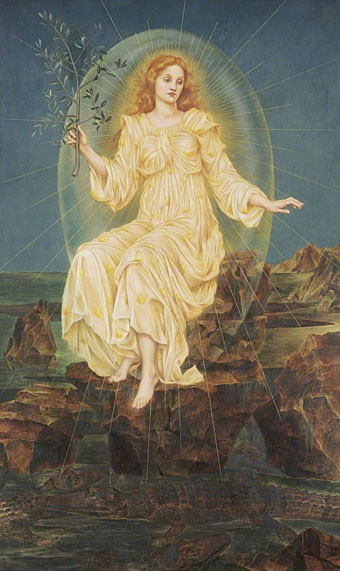Lux in Tenebris (1895) by Evelyn De Morgan.
• “NASA celebrates the worm logo designer, Richard Danne“. Until I read this story (and this one) I wasn’t aware that the NASA logos were known as The Meatball and The Worm.
• The Red Shoes: behind the scenes of the classic Powell and Pressburger film – in pictures. Related: Kings of the movies: Martin Scorsese on Powell & Pressburger.
• The 700th weekend post happens to arrive on Alan Moore’s 70th birthday. Many happy returns to the Northampton Magus.
Fundamentally, we face a choice. Either:
• it’s a coincidence that, of all the possible values that the finely tuned constants of physics may have had, they just happen to have the right values for life;
or:
• the constants have those values because they are right for life.
The former option is wildly improbable; on a conservative estimate, the odds of getting finely tuned constants by chance is less than 1 in 10-136. The latter option amounts to a belief that something at the fundamental level of reality is directed towards the emergence of life. I call this kind of fundamental goal-directedness ‘cosmic purpose’.
As a society, we’re somewhat in denial about fine-tuning, because it doesn’t fit with the picture of science we’ve got used to. It’s a bit like in the 16th century when we started getting evidence that our Earth wasn’t in the centre of the universe, and people struggled to accept it because it didn’t fit with the picture of the universe they’d got used to. Nowadays, we scoff at our ancestors’ inability to follow the evidence where it leads. But every generation absorbs a worldview it can’t see beyond. I believe we’re in a similar situation now with respect to the mounting evidence for cosmic purpose. We’re ignoring what is lying in plain view because it doesn’t fit with the version of reality we’ve got used to. Future generations will mock us for our intransigence.
Philip Goff, professor in philosophy at Durham University, making an argument for cosmic purpose
• At Spoon & Tamago: Exploring Japanese Hell through art from the 12th to 19th century.
• New music: Turning The Prism by Ben Frost, and Sanctuary Of Desire by Steve Roach.
• Mix of the week is DreamScenes – November 2023 at Ambientblog.
• DJ Food looks at Tomi Ungerer’s Electric Circus posters.
• At Dennis Cooper’s: Alain Resnais Day.
• Strange Flowers visits the Villa Stuck.
• Diet Of Worms (1979) by This Heat | Opera Of Worms (1981) by Van Kaye & Ignit| Wormhole (2002) by Cliff Martinez


